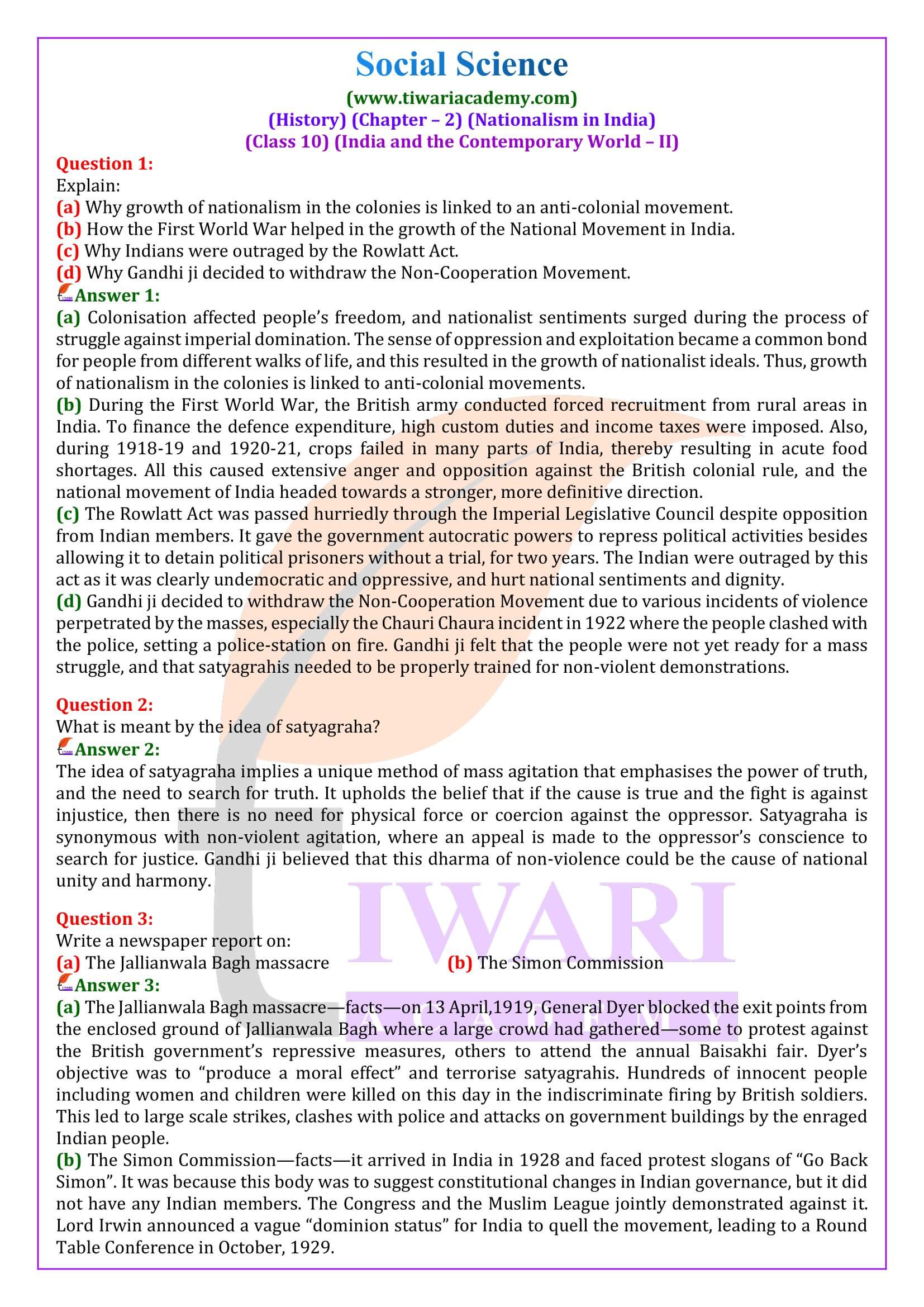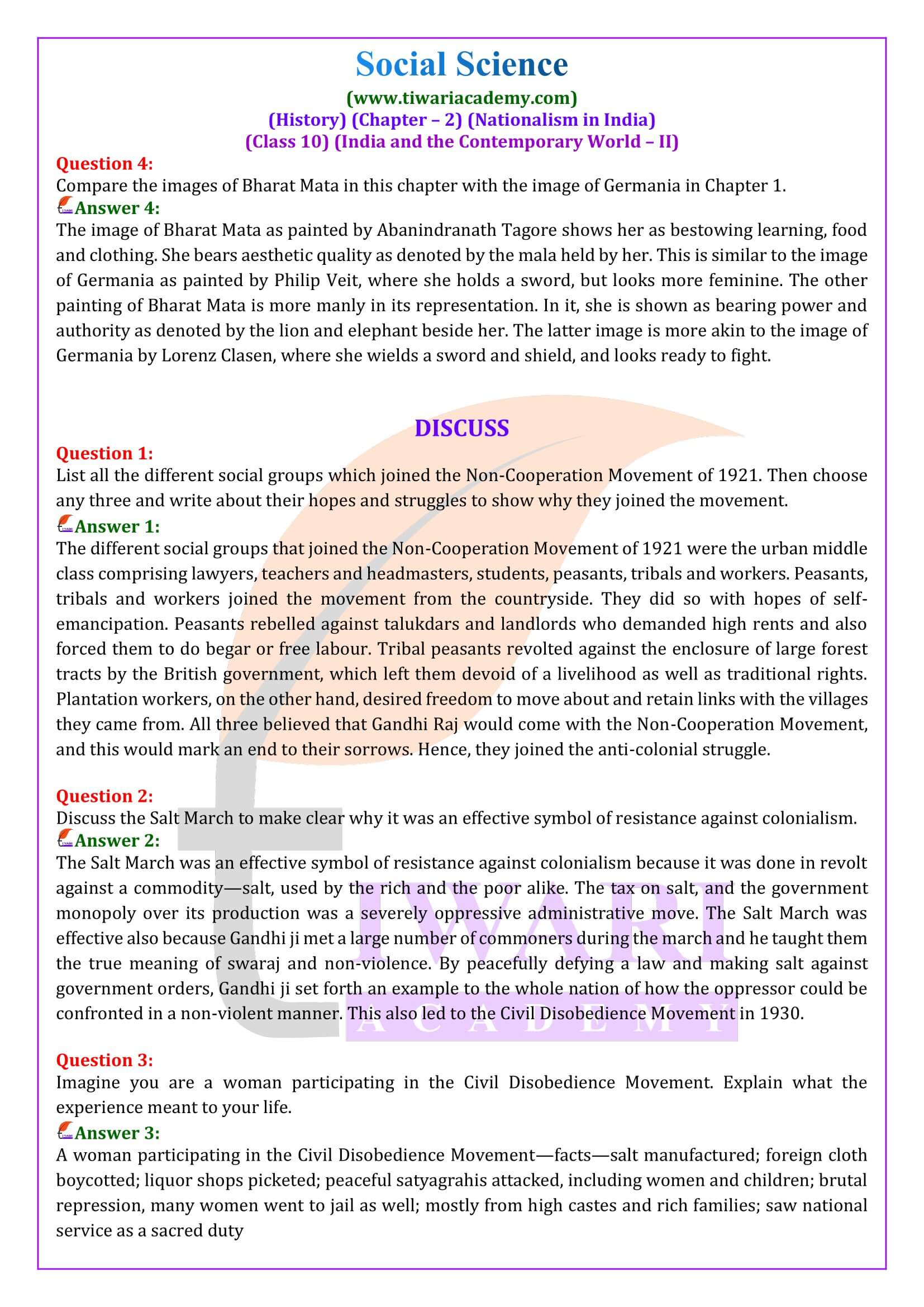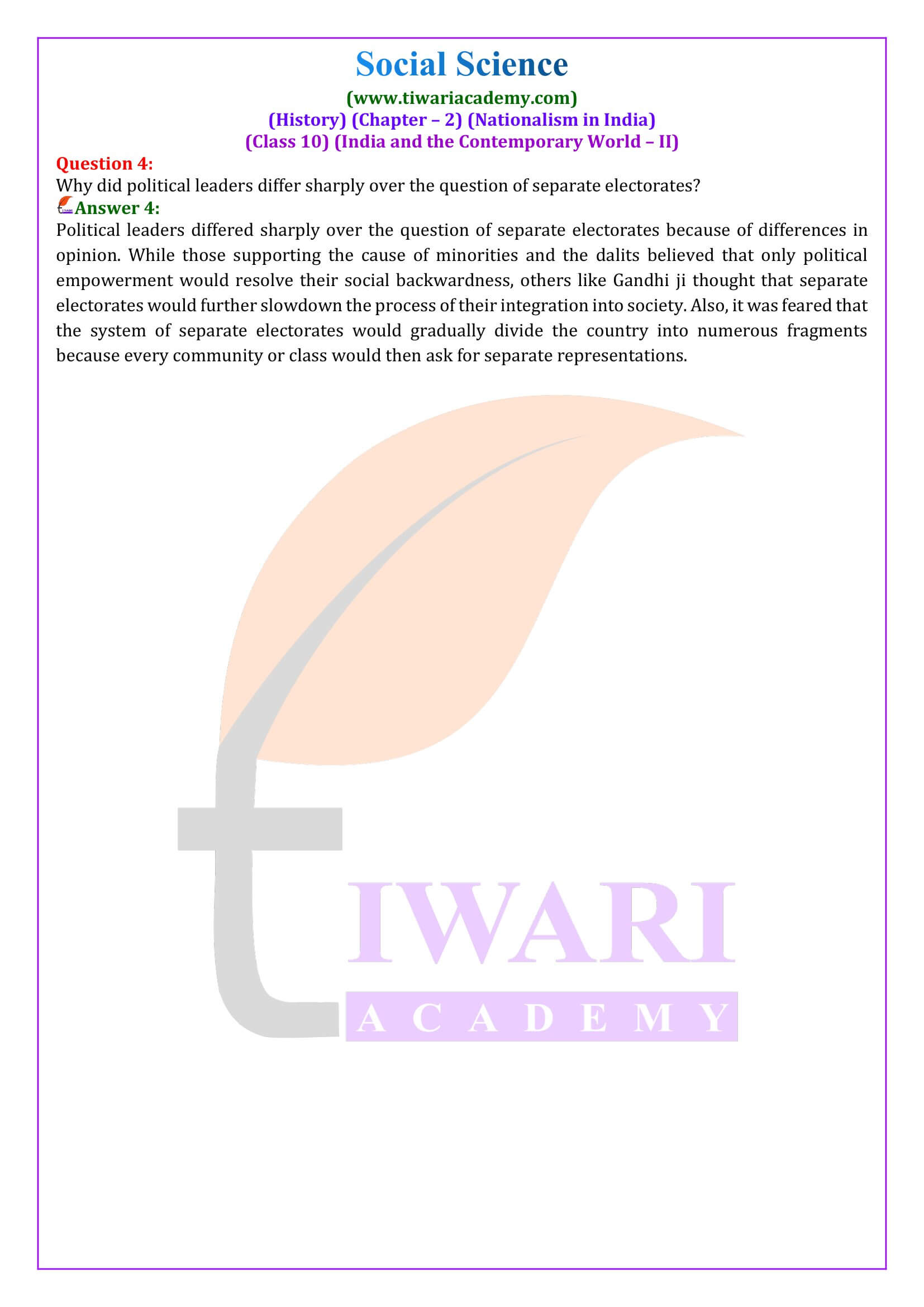NCERT Solutions for Class 10 History Chapter 2 Nationalism in India in English and Hindi Medium updated for new academic session 2025-26 based on revised NCERT Books and following the current CBSE Curriculum for new session. Download Offline Apps and PDF file format contents to use it offline. Ask your doubts and share your knowledge through Discussion Forum.
NCERT Solutions for Class 10 History Chapter 2
NCERT Solutions for Class 10 History Chapter 2
| Class: | 10 |
| Subject: | Social Science – History |
| Chapter 2: | Nationalism in India |
| Academic Session: | 2025-26 |
Class 10 History Chapter 2 Nationalism in India
NCERT Solutions for Class 10 History Chapter 2 in PDF form is given below to free download for new academic session 2025-26. Download Offline Apps based on latest CBSE Syllabus and new NCERT Books for new session.
Exatra Questions Class 10 History Chapter 2
What were the reasons for starting the Khilafat Movement?
i) Humiliating terms of treaty of Versailles on Khalifas
ii) Lucknow Pact
iii) Starting of Non-cooperation by the congress along with khilafat movement.
How did the First World War help in the growth of nationalist movement in India?
i) War created a new political and economic situation. It led to an increase in expenditure.
ii) The war led to a price rise and hardship for common people.
iii) War led to forced recruitment of people.
iv) Acute Shortage of food led to famine and misery.
v) Indians began to realize that they were drawn in a war unnecessarily. This feeling united Indians against the British.
Who was Alluri Sitaram Raju? Explain his role in inspiring the rebels with Gandhijis ideas?
i) Alluri Sita Ram Raju was a tribal leader in the Gudem hills of Andhra Pradesh
ii) He started a militant Guerilla Movement in the early 1920s.
iii) The tribal people were enraged by the British policy, but when the government began forcing them to contribute ‘begar for road building, the hill people revolted.
iv) Raju inspired the hill people. He talked on the greatness of Mahatma Gandhi.
v) Inspired by Gandhiji’s Non Cooperation Movement, he persuaded people to wear Khadi and give up drinking. But at the same time he did not believe in Non Violence, he thought that India could be liberated only by the use of force.
Discuss the role of women in the Civil Disobedience Movement?
i) Women participation was in large scale.
ii) Participated in protest marches, manufactured salt.
iii) Picketed foreign cloths and liquor shops.
iv) Began to see service to the nation as their sacred duty.
Why did Gandhiji choose ‘Salt’ as the symbol of his Civil Disobedience Movement?
i) Salt is consumed by both the poor and the rich, and is one of the most essential items of food everywhere in the world.
ii) The British government had the monopoly on the production of salt in India.
iii) By imposing a ‘salt tax’ the government hit both the rich and the poor, specially the poor. Gandhiji thought it was the most repressive Act of the British government and choose to defy it by breaking the “Salt Law”.
Multiple Choice Questions – MCQ
1. When was the Rowlatt Act Passed?
a). 1912
b). 1914
c). 1919
d). 1920
2. Where did Mahatma Gandhi launch the rst Satyagrah in India?
a). Champaran
b). Kheda
c). Delhi
d). Calcutta
3 Who was the founder of “Depressed Classes Association”?
a). Baba Ram Chander
b). Bhim Rao Ambedkar
c). Jawahar lal Nehru
d), Shaukat Ali
4. After which of the following event, Mahatma Gandhi abruptly withdrew the Non-Cooperation Movement?
a). Jaliawalan Bagh Masscare
b). Rowllat Act
c). Chauri-Chaura
d). Dandi March
5. Who is the author of book “Discovery of India’?
a). Jawahar Lal Nehru
b). Bhim Rao Ambedkar
c). Mahatama Gandhi
d). Baba Ramchander
Answers of MCQ
1. 1919
2. Champaran
3. Bhim Rao Ambedkar
4. Chauri-Chaura
5. Jawahar Lal Nehru
Fill in the Blanks.
1. In……………………………….Session congress demanded complete Independence.
2. First president of Indian National Congress Was…………….
3. Muslim league was formed in ………………..
4. In 1919 Shaukat Ali and Muhammad Ali started ………………movement in India.
5. In……………………………Civil Disobedience Movement was withdrawn.
Fill in the Blanks – Answers
1. 1929, Lahore.
2. W.C Banerjee.
3. 1906.
4. Khilafat Movement.
5. 1931
One Mark Questions
1. Who created the first image of Bharat Mata?
2. What do you mean by the word Satyagrah?
3. Who composed the song Vande Mataram?
4. When was the second round table conference held?
5. Who Started the Awadh Kisan Sabha?
6. What do you understand by the word Swadeshi?
7. Where was the Indian National Congress formed?
8. Why did the British government curtail the freedom of Press after 1857?
9. In Madras who published massive four volume collection of Tamil folk tales?
10. why was Rowlatt act called as an oppressive legislation?
Answers of 1 Mark Questions
1. Abindra nath Tagore
2. Emphasis on the power of Truth.
3. Bankim Chandra
4. 1931
5. Baba Ramchandra
6. Focus on product which was prepared in own country.
7. Mumbai
8. To curb the Arousing spirit of Nationalism.
9. The Folklore of Southern India
10. Under this act political prisoners could be kept in jail for two years without trial.
Summary of the Chapter 2
1. India’s First Freedom Struggle took place in 1857. In 1870 Bankim Chandra composed Vande Matram. In 1885, Congress was formed in Mumbai. W.C. Banerjee chaired the first meeting of Congress.
2. In 1905, Lord Curzon proposed the division of Bengal. In 1905, Abanindra Nath Tagore made a Portrait of Bharat Mata. In 1906, Aaga Khan and Nawab Salimullah established Muslim League.
3. In 1907, Congress was divided into extremists and moderate. In 1911, Delhi Durbar was organized. Bengal Division was abolished in Delhi Durbar.
4. In Delhi Durbar capital was transferred from (Calcutta) Kolkatta to Delhi. In 1914, First World
War started. In 1915, Mahatama Gandhi returned to India.
5. In 1916, Mahatma Gandhi started Champaran Satyagrah in Protest of Indigo plantation. In 1917, Mahatma Gandhi organized Satyagrah for farmers in Kheda Gujarat. In 1918, Mahatma Gandhi started Satyagrah for Craftsman of Cotton Textile mill Gujarat.
6. 1918, the first World War ended. The British Government turned down the demand of Self-rule of Indian. In 1919, British Government gave Rawlatt Act.
7. On 13 April 1919, Jallianwala Bagh massacre took Place in Punjab. In 1919, the Khilafat movement was started by Muhammad Ali and Shaukat Ali. In 1920, Mahatama Gandhi started noncooperation movement.
8. In 1922, Mahatma Gandhi withdrew the non-cooperation movement after the violence took place at
Chauri-chaura. on August 9, 1925 revolutionaries in Kakori looted the train carrying English treasure. In 1928, Simon Commission came to India. Lala Lajpart Rai was killed while protesting.
9. on April 8, 1929 Bhagat singh and Batukeshwar Dutt threw a bomb in the assembly. on 12 March 1930, Mahatma Gandhi started the march from Sabarmati to Dandi. on 6 April 1930, Mahatma Gandhi broke the Salt Law and started Civil-disobedience Movement at Dandi.
10. In 1930, Dr. Ambedkar organized Scheduled caste into depressed Classes Association. On 23rd March 1931, Bhagat Singh, Sukhdev and Rajguru was hanged. In 1931 Gandhi-Irwin pact was signed and Civil disobedience movement was suspended.
11. In 1931, Mahatma Gandhi participated in Second round table conference but did not get expected success. In 1932, Poona Pact was signed between Mahatma Gandhi and Dr. Ambedkar. In 1933, Choudhary Rahmat Ali first coined the idea of Pakistan.
12. In 1935, Indian Government Act was passed and regional government was formed. 1939 World war II was started. In 1940, A resolution was passed by Muslim League for separate homeland for Muslims
named Pakistan.
13. In 1942, the Quit India movement was started by Mahatma Gandhi. He gave the slogan Do or Die. IN 1945, USA dropped nuclear Bomb on Japan and Second World War was ended. In 1946, Cabinet
Mission came to India with the proposal of constituent assembly.
Important Questions on Class 10 History Chapter 2
Why growth of nationalism in the colonies is linked to an anti-colonial movement.
Colonisation affected people’s freedom, and nationalist sentiments surged during the process of struggle against imperial domination. The sense of oppression and exploitation became a common bond for people from different walks of life, and this resulted in the growth of nationalist ideals. Thus, growth of nationalism in the colonies is linked to anti-colonial movements.
How the First World War helped in the growth of the National Movement in India.
During the First World War, the British army conducted forced recruitment from rural areas in India. To finance the defence expenditure, high custom duties and income taxes were imposed. Also, during 1918-19 and 1920-21, crops failed in many parts of India, thereby resulting in acute food shortages. All this caused extensive anger and opposition against the British colonial rule, and the national movement of India headed towards a stronger, more definitive direction.
Why Indians were outraged by the Rowlatt Act.
The Rowlatt Act was passed hurriedly through the Imperial Legislative Council despite opposition from Indian members. It gave the government autocratic powers to repress political activities besides allowing it to detain political prisoners without a trial, for two years. The Indian were outraged by this act as it was clearly undemocratic and oppressive, and hurt national sentiments and dignity.
Why Gandhi ji decided to withdraw the Non-Cooperation Movement.
Gandhi ji decided to withdraw the Non-Cooperation Movement due to various incidents of violence perpetrated by the masses, especially the Chauri Chaura incident in 1922 where the people clashed with the police, setting a police-station on fire. Gandhi ji felt that the people were not yet ready for a mass struggle, and that satyagrahis needed to be properly trained for non-violent demonstrations.
What is meant by the idea of satyagraha?
The idea of satyagraha implies a unique method of mass agitation that emphasises the power of truth, and the need to search for truth. It upholds the belief that if the cause is true and the fight is against injustice, then there is no need for physical force or coercion against the oppressor. Satyagraha is synonymous with non-violent agitation, where an appeal is made to the oppressor’s conscience to search for justice. Gandhi ji believed that this dharma of non-violence could be the cause of national unity and harmony.
Write a newspaper report on The Jallianwala Bagh massacre.
The Jallianwala Bagh massacre—facts—on 13 April,1919, General Dyer blocked the exit points from the enclosed ground of Jallianwala Bagh where a large crowd had gathered—some to protest against the British government’s repressive measures, others to attend the annual Baisakhi fair. Dyer’s objective was to “produce a moral effect” and terrorise satyagrahis. Hundreds of innocent people including women and children were killed on this day in the indiscriminate firing by British soldiers. This led to large scale strikes, clashes with police and attacks on government buildings by the enraged Indian people.
Write a newspaper report on The Simon Commission.
The Simon Commission—facts—it arrived in India in 1928 and faced protest slogans of “Go Back Simon”. It was because this body was to suggest constitutional changes in Indian governance, but it did not have any Indian members. The Congress and the Muslim League jointly demonstrated against it. Lord Irwin announced a vague “dominion status” for India to quell the movement, leading to a Round Table Conference in October, 1929.
Compare the images of Bharat Mata in this chapter with the image of Germania in Chapter 1.
The image of Bharat Mata as painted by Abanindranath Tagore shows her as bestowing learning, food and clothing. She bears aesthetic quality as denoted by the mala held by her. This is similar to the image of Germania as painted by Philip Veit, where she holds a sword, but looks more feminine. The other painting of Bharat Mata is more manly in its representation. In it, she is shown as bearing power and authority as denoted by the lion and elephant beside her. The latter image is more akin to the image of Germania by Lorenz Clasen, where she wields a sword and shield, and looks ready to fight.
The different social groups that joined the Non-Cooperation Movement of 1921 were the urban middle class comprising lawyers, teachers and headmasters, students, peasants, tribals and workers. Peasants, tribals and workers joined the movement from the countryside. They did so with hopes of self-emancipation. Peasants rebelled against talukdars and landlords who demanded high rents and also forced them to do begar or free labour. Tribal peasants revolted against the enclosure of large forest tracts by the British government, which left them devoid of a livelihood as well as traditional rights. Plantation workers, on the other hand, desired freedom to move about and retain links with the villages they came from. All three believed that Gandhi Raj would come with the Non-Cooperation Movement, and this would mark an end to their sorrows. Hence, they joined the anti-colonial struggle.
Discuss the Salt March to make clear why it was an effective symbol of resistance against colonialism.
The Salt March was an effective symbol of resistance against colonialism because it was done in revolt against a commodity—salt, used by the rich and the poor alike. The tax on salt, and the government monopoly over its production was a severely oppressive administrative move. The Salt March was effective also because Gandhi ji met a large number of commoners during the march and he taught them the true meaning of swaraj and non-violence. By peacefully defying a law and making salt against government orders, Gandhi ji set forth an example to the whole nation of how the oppressor could be confronted in a non-violent manner. This also led to the Civil Disobedience Movement in 1930.
Imagine you are a woman participating in the Civil Disobedience Movement. Explain what the experience meant to your life.
A woman participating in the Civil Disobedience Movement—facts—salt manufactured; foreign cloth boycotted; liquor shops picketed; peaceful satyagrahis attacked, including women and children; brutal repression, many women went to jail as well; mostly from high castes and rich families; saw national service as a sacred duty.
Why did political leaders differ sharply over the question of separate electorates?
Political leaders differed sharply over the question of separate electorates because of differences in opinion. While those supporting the cause of minorities and the dalits believed that only political empowerment would resolve their social backwardness, others like Gandhi ji thought that separate electorates would further slowdown the process of their integration into society. Also, it was feared that the system of separate electorates would gradually divide the country into numerous fragments because every community or class would then ask for separate representations.






